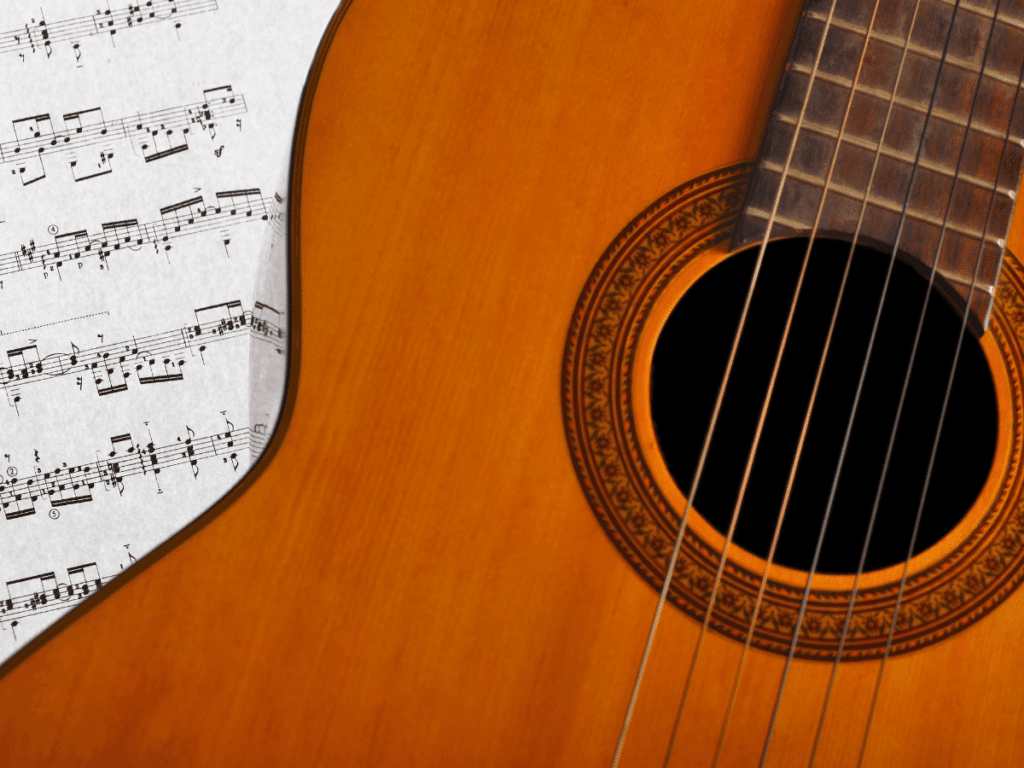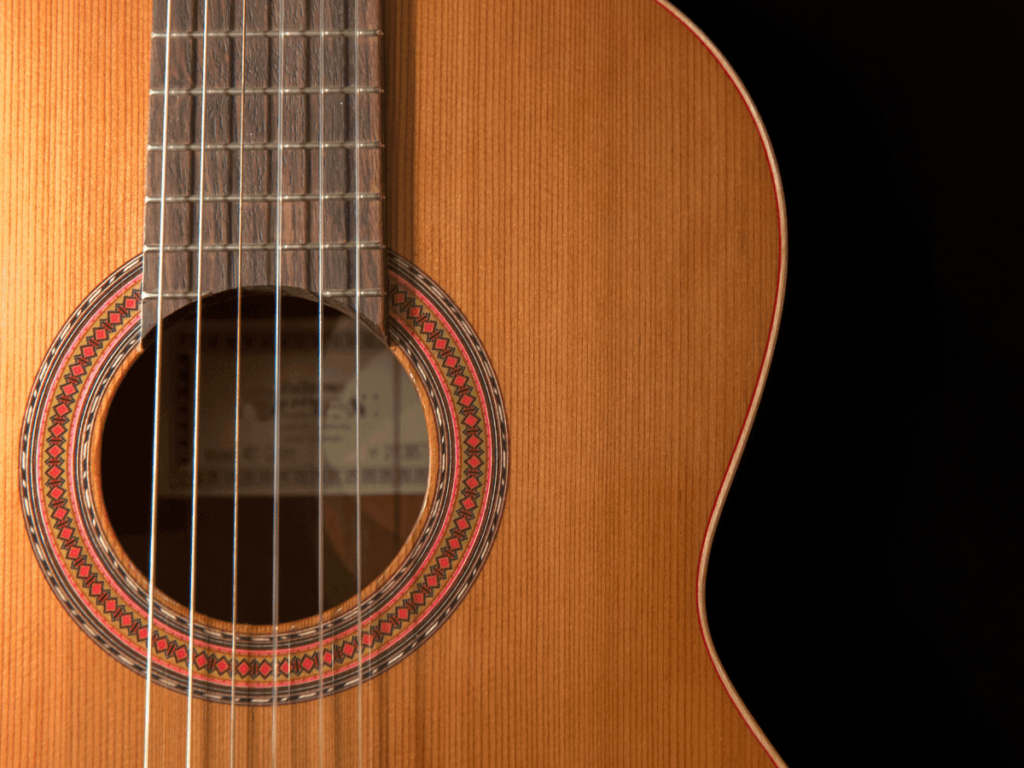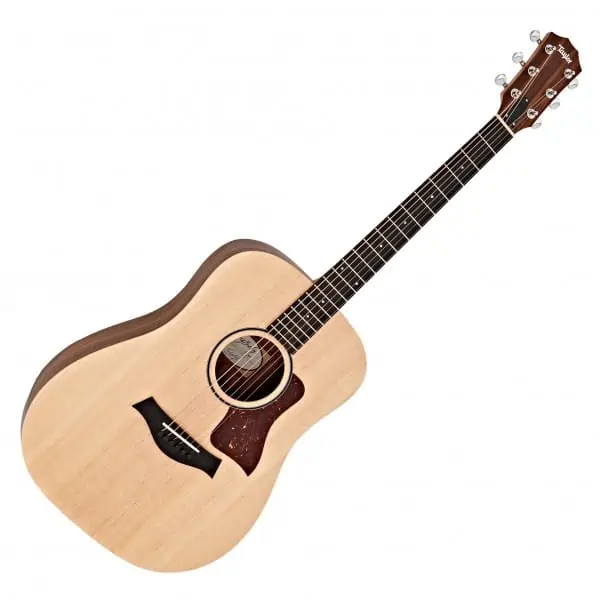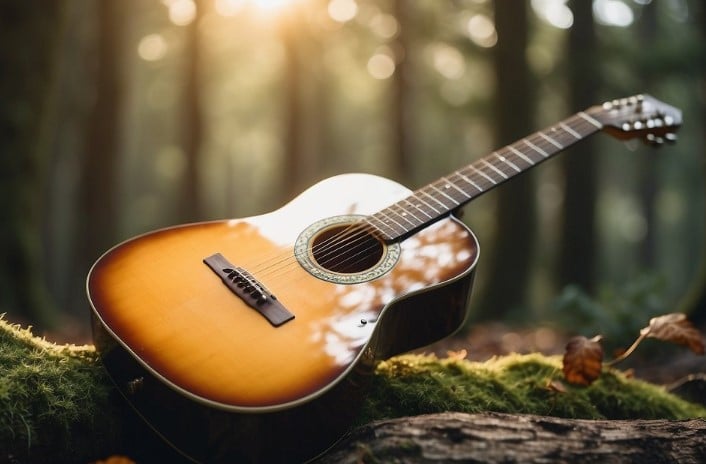BEST BUDGET
GUITAR FOR A BEGINNER
-
Overall: 8/10
-
Best Feature: Laminated spruce top and mahogany body
-
TedScore™: 8/10
BEST BUDGET
GUITAR
FOR THE SMALLER PLAYER
-
Overall: 8/10
-
Best Feature: Modified low oval neck style
-
TedScore™: 8/10
BEST OVERALL
HIGH-END BUDGET GUITAR
-
Overall: 9/10
-
Best Feature: Features a sublime quality solid sitka spruce top.
-
TedScore™: 9/10
**Have you ever strummed a guitar and felt the magic at your fingertips? That’s the charm of Guitar Wood.**
My adventure with guitars started with a simple wooden acoustic guitar that made beautiful music every time I played a note, and it’s where I learned my first crucial lesson: the wood defines the sound.
I was thrilled when I started learning about tone woods and discovered how each has its special sound, like different spices in a musical recipe.
Each has its distinct personality, setting the stage for those magical musical moments, and If I had to pick a favorite, mahogany’s warm embrace in the midrange would steal the show for me.
By the end of this article, you’ll understand why selecting the right wood is more than just aesthetics—it’s about discovering your unique sound.
Selecting Wood for Different Guitar Types
When it comes to building guitars, the choice of wood is crucial for crafting the distinctive sound and feel of the instrument. Let’s see which woods best suit acoustic and electric guitars.
Acoustic Guitars
Acoustic guitars benefit significantly from solid wood construction, allowing for resonant, warm tones. The top, or soundboard, is particularly influential because it amplifies the strings’ vibrations.
Sitka spruce
Rosewood
Engelmann and Adirondack
Honduran Mahogany
Electric Guitars
Electric guitars are a different beast, relying on pickups to convert string vibrations into electrical signals; thus, the wood contributes more to sustain and feel than pure acoustic tone.
Alder
Maple
mahogany
Characteristics of Common Guitar Woods
When I look at the different woods used in guitar making, I’m amazed by how each one brings its unique flavor to the music.
It’s like each type of wood has its personality, with specific tonal qualities, weight and density, and grain and appearance that color the sound and feel of a guitar.
Tonal Qualities
Maple usually sings with a bright tone and has good sustain, making it a popular choice for necks and bodies.
But let’s not forget Mahogany, with its warm, rich voice, often used in acoustic and electric guitars for a robust midrange.
On the lighter side, Alder offers a full-bodied and balanced tone, while Basswood is known for its warmth, catering beautifully to diverse playing styles.

Weight and Density
Some woods, like Ebony and Brazilian Rosewood, are on the heftier side, which can contribute to rich sustain and resonance.
In contrast, Swamp Ash or Poplar is often lighter, providing a comfort that’s easy on the shoulders without compromising tone.
And then there’s Walnut, striking a delightful balance between weight and tone for a natural Goldilocks choice.

Grain and Appearance
Now, let’s talk style.
The grain of the wood affects not only the aesthetics but sometimes even the guitar’s resonance.
Figured Maple, with its captivating flamed or quilt patterns, turns any guitar into a visual treat.
Indian Rosewood seduces with simpler, elegant grain patterns.

And exotic woods like Cocobolo or Wenge? They’re like the final flourish on a masterpiece, with distinct, mesmerizing patterns as unique as fingerprints.
Anatomy of the Guitar
In exploring the guitar’s anatomy, I think of it as a work of art, where each wooden piece contributes to its unique sound and feel.
It’s intriguing how the choice of wood in different guitar parts, such as the body, neck, and fretboard, affects the instrument’s character and tone.
Body
Neck
Fretboard
Guitar Wood Maintenance and Care
I like to keep things simple yet effective when it comes to maintaining my guitar. I know that the wood is the soul of my guitar; it contributes to its durability and stability, and of course, that rich sound I love.
Humidity is my guitar’s best friend and worst enemy, all rolled into one. I maintain a humidity level between 45-55% to ensure the wood doesn’t warp or crack, affecting playability and tone.
I’m also careful about the temperature where I store my guitar. Not too hot or cold, just right, between 72-77 degrees Fahrenheit. This way, I prevent damage to the lacquer finish and keep the wood’s stability in check.
Cleaning is an art form. I clean the body and neck with a soft, dry cloth, and for stricter grime, I use guitar-specific cleaners that won’t harm the wood.
As for the fretboard, that’s the part my fingers dance on, and it directly affects the feel and playability. I gently clean it with extra-fine steel wool but always mask the sound hole first to keep the insides clean.
Thickness and Volume, oh, how they are intertwined with the wood. The thickness of the guitar wood can influence the Volume and resonance, so I keep an eye on any changes due to swelling or shrinking from humidity. I choose woods from responsibly managed forests for my next guitar when I think of sustainability. It’s my way of caring for the environment while caring for my treasured instrument. A little thoughtfulness goes a long way, ensuring that my six-string friend sings beautifully for years to come!
Advanced Considerations in Guitar Wood Selection
When I think about crafting a guitar, the selection of wood is critical to the character and voice of the instrument. It’s a blend of art and science determining how notes resonate with each strum.
Tone wood Basics and Definition
The Importance of Wood Density and Grain Pattern
Budget Guitar Recommendation
FENDER FA-115

FEATURES: Laminated spruce top and mahogany body.
- Features walnut fingerboard and a clear gloss finish.
- Exceptional playability.
- Classic blend of tone woods.
- Perfect for beginners.
- Lack of accessories.
When you click ‘Check Price’, you’ll see there are loads of great places to buy this item. Our personal favorite is Sweetwater for the US, and Thomann and Gear4Music for the UK & Europe.
They are the largest music retailers, with excellent customer service, competitive prices, really fast shipping, and the longest guarantees.
The professional musician who wrote this article combined many things,
from the product build, manufacturer’s reputation through to feedback
from other users, to create our famous TedScore™.
MARTIN LX1 LITTLE MARTIN

Young Players
FEATURES: Solid sitka spruce top.
- Modified low oval neck style.
- Small size makes it perfect for the young crowd
- Premium solid top emanates clear and intricate sound when strumming.
- Laminated wood body lowers its quality construction
When you click ‘Check Price’, you’ll see there are loads of great places to buy this item. Our personal favorite is Sweetwater for the US, and Thomann and Gear4Music for the UK & Europe.
They are the largest music retailers, with excellent customer service, competitive prices, really fast shipping, and the longest guarantees.
The professional musician who wrote this article combined many things,
from the product build, manufacturer’s reputation through to feedback
from other users, to create our famous TedScore™.
BIG BABY TAYLOR BBT

Experienced Players
FEATURES: Features a sublime quality
solid sitka spruce top.
- Solid Sitka spruce top.
- Excellent playability.
- Produces dynamic sound.
- Large size may not be suitable for younger players.
When you click ‘Check Price’, you’ll see there are loads of great places to buy this item. Our personal favorite is Sweetwater for the US, and Thomann and Gear4Music for the UK & Europe.
They are the largest music retailers, with excellent customer service, competitive prices, really fast shipping, and the longest guarantees.
The professional musician who wrote this article combined many things,
from the product build, manufacturer’s reputation through to feedback
from other users, to create our famous TedScore™.
Guitar Wood
Top Picks
Choosing guitar wood is like picking the perfect ingredient for a delicious recipe. I’ve discovered that the type of wood shapes the guitar’s aesthetics and its very soul.
Mahogany whispers warm, rich tones, making it a friend to many styles. Meanwhile, maple stands bold and bright, offering sonic clarity that cuts through the mix.
My journey through tone woods taught me about the resonance of top woods.

Let’s remember how wood choice affects playability and longevity. It’s thrilling to find that perfect match where feel and durability meet.
In my quest for the ultimate guitar sound, I urge you to play different guitars made from various woods. Feeling the vibrations and hearing the tone differences first-hand is eye-opening.
Now, here’s a nifty breakdown:
Tone wood Impact: Affects sound, longevity, and playability.
Popular Choices: Mahogany and maple for beginners.
Top Wood Importance: Key to superior resonance and tone.
Before you go…
Discover the top 18 acoustic guitars priced under 500 in this article.
FAQ's
The best wood for a guitar depends on the player’s preferences and the desired sound. Common choices for acoustic guitar tops include spruce, cedar, and mahogany, each offering distinct tonal characteristics. In contrast, electric guitars often use woods like alder, ash, mahogany, and maple for different instrument parts, each contributing to the overall sound and feel. Ultimately, the “best” wood is subjective and varies based on individual playing style and musical genre.
Guitars can be made from various types of wood, with different woods often used for the body, neck, and fretboard. Other hardwoods for acoustic guitar tops include spruce, cedar, and mahogany, while electric guitars often use woods like alder, ash, mahogany, and maple for different instrument parts. The choice of wood can significantly impact the guitar’s tone and overall feel.
The most common wood for acoustic guitar tops is spruce, mainly Sitka spruce, due to its balance of strength and tonal qualities. Alder and ash are widely used for solid-body construction for electric guitars, while maple is commonly used for necks and fretboards.
Cheap guitars are often made from more affordable tone woods such as dense wood, basswood, sand, or poplar for the body. They may feature synthetic materials for the fretboard and other components. These materials help to reduce production costs, making the guitars more budget-friendly.











really enjoyed reading about the guitar anatomy, didn’t know much about it before. thanks for the info 🙂
While I appreciate the section on tone woods, I believe you’ve oversimplified their impact on electric guitars. The electronic components like pickups play a far more significant role in shaping the sound. Wood’s effect, while not negligible, is more subtle and becomes apparent only in high-quality instruments played through high-end amplification.
nice breakdown on electric guitars, always thought the wood type was just about the looks lol didn’t know it affected the sound that much
Hey Lewis , I’m kinda new to this whole guitar thing and was wondering how much the type of wood really matters for someone just starting out? Does it make learning easier or sound better even if I’m not that good yet?
Good wood contributes to better sound, but it’s technique that truly makes a difference. Starting on any decent guitar is fine.
MaggieS, the wood can definitely impact the sound, but when you’re starting out, focus on comfort and playability. You’ll appreciate the tone differences more as you progress.